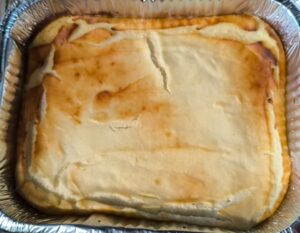I’ve been a fan of sushi since I was a kid and have passed on that love of sushi to my kids.
The first time I ever had sushi was on a trip to New York when I was in elementary school. We stopped at a restaurant just as we were about to come home, had a variety of different types of sushi, and quickly became hooked.
One day by chance I made a discovery- a sushi hack- that has since transformed my world of sushi. I discovered how to make cheater fast sushi. Cheater fast meaning not the official “right” rice, but a super easy, low maintenance rice, but it works well, my kids love it, it’s no headache. All of a sudden sushi can become a regular occurrence in my house.
Though I prefer the texture of basmati rice, with its separate individual grains, ever since I started making risotto, my kids expressed that they enjoy the sticky short grain rice more than medium or long grain rice.
Since I am easily distractable, and have burned rice more often than I can count by forgetting that it was on the stove, I’ve begun to bake my rice in the oven. It usually takes either 1 1/4 times to twice as long in the oven vs the stove top (depending on whether you start with boiling water or not), but it also is more flexible and doesn’t burn if you leave it in too long.
One day I baked some short grain rice in the oven for lunch, and there were some leftovers. The kids asked me if I could make sushi and I had a spark of inspiration. What would happen if I took the sweet and sour liquid that I add to my sushi rice once cooked and added it to the leftover oven baked short grain rice? I experimented and voila- it worked! This oven baked, unsoaked, unwashed, un-anything that makes it complicated and hard to cook short grain rice worked beautifully in sushi! Is the texture identical to sushi rice cooked the “standard way”? Not 100%, but it’s very close (albeit a drop more mushy), and for the amount of work it saved, this new-to-me way of making sushi rice is now how I make sushi; it has completely changed my sushi game.
So how do you do it?
Cheater Fast Sushi Rice
Take 2 cups of short grain white rice and put it in a baking pan and add 4 cups of water, either boiling or cold, to the pan.
Cover well, and bake in a preheated oven for 30-45 minutes if using boiling water, and 45-60 minutes if using cold. (Check to make sure the rice is fully cooked and has absorbed all the water.)
As soon as the rice is cooked, make your sweet and sour sauce.
In a small saucepan mix:
1/3 cup vinegar (I use apple cider vinegar; rice vinegar and white vinegar are also options) or 1/3 cup plus one tablespoon lemon juice
3 tablespoons sweetener of choice (I switch between honey, jaggery syrup, and date syrup, but white sugar or demerara sugar also works)
1 teaspoon salt
Bring the sauce to a boil, and pour onto the hot rice, mixing it in well, so the flavor gets evenly distributed.
Let the rice cool down, uncovered, until it reaches room temperature. Usually this takes about 30 minutes, maybe a little bit more.
While that is happening, I prepare my filling.
Sushi Filling
If I have sushi grade fish (an expensive luxury that I usually skip) I slice that into thin strips. Other fillings I include are:
Omelets cut into strips roughly one inch wide. Tamago sushi is a type of sushi made with a special type of omelet- I just use regular old plain omelets for these.
Cooked fish. Last time I made sushi I used salmon that I deboned from free salmon “frames” I got in the market, but any type of cooked, boneless fish works, whether canned tuna or salmon, white fish, or whatever.
Onions add a nice touch to sushi. You can saute up onions with a little bit of ginger (my mom always did this for a sushi filling growing up, and it is delicious) and use that, or scallions or chives or onion greens. If using green onions of any kind, I find long strips, the length of the entire nori sheet, actually work best placed in the sushi with the rest of the filling, instead of chopped up.
Carrots can be either cooked or raw. My mom always made thin spears and sauted them up together with the onion and ginger mentioned above, but I don’t bother. I just cut the carrots in thin long strips and use them raw in the sushi. (If you can manage to cut the carrots thin but still long enough to span the entire width of the nori sheet, it works best, but isn’t required.) The only caveat about carrots when used raw is you need to make sure that they are thin enough that they are easy enough to bite. No thicker than a number 2 pencil, but ideally a little thinner.
Cucumbers: These add a nice crunch and take pretty much zero prep work, so a go-to for my fast sushi. I use smaller cucumbers, so just slice them lengthwise, lay each half flat on the cutting board, and cut them lengthwise into two to four long pieces depending on how thick of a cucumber it is. As with all the other fillings, when you make them as long as the nori paper it works best (because then when you squeeze the roll after filling it, the two halves don’t pop out separate ends of your sushi roll, the way that can happen when you use shorter pieces.)
Sweet potato: Bake a sweet potato (pop it into the oven at the same time as your rice to hit two birds with one stone), and then when cool, chop it into long thin-ish wedges. Because your sweet potato will be soft, you can have thicker pieces of sweet potato than you can have with other, harder vegetables.
Bell pepper: I sometimes include these if I have some lying around. Just do long thin strips, raw.
Avocado tastes delicious in sushi but it can be pricier so I don’t often use it. It also tends to be slippery and can squeeze out from the sides of the roll, so be careful when using avocado.
Other Veggies: you can use so many other vegetables in your sushi, the only limit being your imagination. I’ve used steamed wild greens, raw purslane, sauted mushrooms, and cactus paddles. You can use broccoli, green beans, butternut squash… whatever you want.
Fruit: If you want to be bold, you can add some soft sweet fruit, like mango, peaches, apricots, or anything else.
I usually try to have between three and four types of filling in each roll of sushi, and mix and match according to what I have available or I’m in the mood to eat.
Once you have your rice and fillings prepared, just follow these instructions to roll it and you’re good.
Paleo Grain Free Sushi
Now for paleo sushi, you need to leave out the rice.
Since rice is what generally bulks up sushi and fills in the nori paper around the other fillings, I find you need something starchy and a bit mushy like sweet potatoes in paleo sushi. I tend to put two wedges of sweet potato in my paleo sushi rolls instead of the rice and it seems to work well in its place.
To make paleo sushi, first know that it won’t necessarily be as aesthetic as rice based sushi, as it can be harder to cut. If you don’t want to risk the sushi making a big mess when you attempt to cut it (which can happen), try cutting the nori sheets in half, so that each roll is only half the width of a regular sushi roll, and you can even serve them uncut, as shown below, if you don’t want to risk tearing when cutting them into smaller circles.
To fill them, lay your half sheet of nori on your bamboo mat, so that it looks thin and tall (as opposed to wide and short) and then lay out your fillings. When doing paleo sushi, include one to two spears of sweet potato, at least 2 vegetables, and fish (or egg, if you eat it… I don’t), then roll it up jelly roll style, wetting the ends of the nori so that it sticks together.
Repeat with the rest of your nori papers.
Let them sit for at least 5 minutes before attempting to cut them, and if you do, cut them very, very carefully as these fall apart and rip more easily because of the lack of the stickiness of the rice holding to together.
Some people reading this might say that this doesn’t sound like such fast or easy sushi… and you know what? First of all, practice makes perfect, and the more often you roll sushi rolls the faster that aspect is… But secondly? This post makes it sound like more work than it really is- it took me much more time to write this post than it took me to make 9 rolls of sushi, including 2 paleo rolls for my guests last night.
If you’ve ever made sushi, do you find it to be a lot of work, or quite easy? If you’ve figured out a short cut to make your sushi faster, what is it?









0 Responses
When I make sushi rice, after cooking and adding the vinegar-sugar sauce, I spread it out onto a tray or a piece of baking paper on the table in order to have it cool down much more quickly.
When I make sushi rice, after cooking and adding the vinegar-sugar sauce, I spread it out onto a tray or a piece of baking paper on the table in order to have it cool down much more quickly.
Wow, I want to try this kind of sushi, I guess it's healthier. Thanks for sharing!
I guess we are not as particular about the consistency of sushi rice, because we have often made sushi using leftover, previously cooked rice reheated in the sweet and sour sauce and let cool! Spreading it out, as another commenter suggested, cools it faster, so we can be ready to roll in 20-30 minutes.
We actually make sushi only a couple of times a year. More often, we get out the seaweed when we are having Japanese/Chinese food, and those who want to can roll it up in a nori sheet. My 3-year-old especially likes this and has been known to request seaweed with a non-Asian meal!
I guess we are not as particular about the consistency of sushi rice, because we have often made sushi using leftover, previously cooked rice reheated in the sweet and sour sauce and let cool! Spreading it out, as another commenter suggested, cools it faster, so we can be ready to roll in 20-30 minutes.
We actually make sushi only a couple of times a year. More often, we get out the seaweed when we are having Japanese/Chinese food, and those who want to can roll it up in a nori sheet. My 3-year-old especially likes this and has been known to request seaweed with a non-Asian meal!
I just made this, it came out great, thanks!
I just made this, it came out great, thanks!